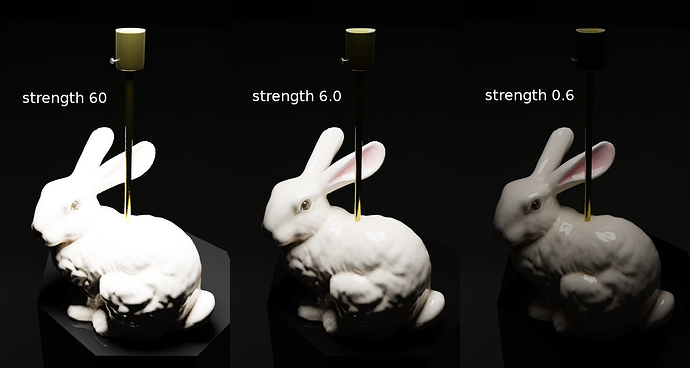Sorry, googling’s failed.  Is there a list somewhere of settings for making real-world equivalent lights for use with Troy Sobotka’s Filmic OpenColorIO configuration of Blender’s color management? Like if I want something that casts roughly the same amount of light as a 60 watt incandescent light bulb, what type of lamp (I’m assuming point, but) should I use at what strength?
Is there a list somewhere of settings for making real-world equivalent lights for use with Troy Sobotka’s Filmic OpenColorIO configuration of Blender’s color management? Like if I want something that casts roughly the same amount of light as a 60 watt incandescent light bulb, what type of lamp (I’m assuming point, but) should I use at what strength?
To my knowledge, light strength is in watts and emissive materials in watts per square meter of surface. Sun lamp produces irradiance of watt per square meter of perpendicular surface for one unit. One blender unit is equivalent to one meter by default. But in practice, relative strength is all that matters. The fact that emission strength of 1.0 with unity white produces linear value of 1.0 should give some insight into what the relation of blender default exposure to real world camera is: for example, what should the aperture-iso-shutter combination be to produce ~2.5 stops above middle gray with 1w/m2 emissive surface.
So no list is necessary because it can be calculated? Great! But (excuse my noobishness and ignorance) from what you’ve posted I’m not seeing how to do this.
How to do what exactly? What do you want to achieve?
If you want, for example, 60W and 100W bulbs, use values of 0.6 and 1.0, 6.0 and 10.0, 60.0 and 100.0 etc and adjust the exposure accordingly. Relation is important, absolute values not so much. Choose type of lamp by how it emits light: uniformly in all directions (point), as a projector (spot), as sun with parallel rays (sun), from flat surface (area or emissive object).
This is a simple approach ofcourse. If you want to use color temperatures, IES profiles and so on, you should be more specific about what you want and what you need.
Obtain light efficacy from the manufacturer. Today that 0.1 (6-12%) rarely applies, but have higher efficiency.
For sun, have a look at this. If doing mixed light (practicals, motivation, sun&sky), simulate actual modifiers (both nd and color temperature wise) like photographers do in the real world to get the best shot rather than the most realistic which tends to be crappy. Maybe render them out separately and adding them together in post for best control.
The one thing that I thought I understood from kesonmis’ answer was that a white point lamp with a strength of 60 was the equivalent of a 60 watt light bulb – now I’m confused again.
So I did some test renders with your values: a ceramic Stanford Bunny as a child’s bedside light, with a white point-lamp about where the lightbulb’s filament would be, the HDRI strength turned down to 0.005, the Exposure on the default of 1, and filmic. Three renders with the lamp’s strength at 60, 6, and 0.6 – none of 'em looked like the light from a 60 watt incandescent bulb (two of them were too bright, one too dim). I was about to post them with “what am I doing wrong” when I realized that I’d scaled everything (including the position of the point-lamp) to the bunny I’d been working on earlier, which wasn’t even close to the size of one on a bedside lamp. Fixed that (against the one in my bedroom), rendered again, and the one with the point lamp on a strength of 6 looks much like the light from a white 60 watt lightbulb in a dark room. Eureka!
But I still don’t understand why the right strength’s 6 instead of 60.
I’m not a photographer – since “with filmic blender you don’t really have to cheat like you were used to and you can use way more realistic values when it comes to setting up lights”, I want to know what the realistic values are. Thanks for your recommendation of Johnson Martin’s informative article, but that says it only addresses the values for Sun and Mesh lamps because they’re measured in units of irradiance – it ignores all other lamp types because they are measured using “another system”. Since some of my renders will be indoors and lit by light bulbs, I also want to know what the realistic values for point lamps are. (And the rest of 'em while I’m at it, just in case.)
When buying light bulbs I like warm white (2700-3000 kelvin), but I figured I could get into color temperature later – for the purposes of this discussion I’m sticking with simple white.
First off, they all look like a 60W bulb on dark room, just one is exposed correctly, one over and one under. This is why I wrote about first finding out what the default exposure equals to camera settings wise.
Other thing to note is that filmic is a post-processing effect, a tone mapping. It basically rolls off the highlights to produce a more pleasing image, similar to how analog film reacts ro light. But it does not change lights themselves in any way before or during render. Cheating has the purpose of artificially creating (“modeling” if you like) this pleasing rolloff by using non-realistic relations and falloffs, using filmic makes these cheats unnecessary.
Sorry I didn’t respond a year ago – this pretty much blew my mind for a while. Thanks for your help!
Hey there! I ran into this same issue with the lights in eevee. I have no idea how these things work. Right now, I have 6 lights at 1W and they are waaaaay too bright for being just 1W. Did you ever figure out how this works?
